Today, we continue our survey of toons focusing on the almost camera-invisible target of the common flea. As noted in last week’s installments, character design had now run the gamut from mere black dots to miniature sensual humanized chorus girls. Anything goes was now the rule of the day in dealing with the miniature mites, who could carry a picture on their own when called for.
One writer had obviously taken note of these trends, and was about to launch a series of scripts which would appear in productions of various studios, building off the precedents set by Tex Avery at MGM. His legacy (which was already prolific in many directions for Chuck Jones’ unit at Warner Brothers) would span the studios of Warner, Walter Lantz, and a flock of titles for Hanna-Barbera. His name – legendary Michael Maltese.
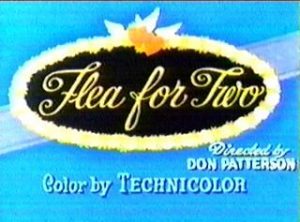 Flea For Two (Lantz/Universal, 8/29/55 – Don Patterson, dir., Michael Maltese, story), follows directly in the tiny footsteps of Avery’s outings of the preceding year, again using the concept of depicting fleas as tiny big-headed humanoids. This time, our starting focus is on a country barn dance – taking place on the backside of a dog in a barn, where a hick country flea (Flea Wee) celebrates his anticipated wedding day to follow in a night of frivolity with his girl (Flora). Mike Maltese is channeling the rival Tex Avery product in two directions at once – not only lifting ideas for character design out of “The Flea Circus”, but also stealing the basic melodrama script from Avery’s earlier MGM production, “The Hick Chick” (1946), by having appear outside the barn dance a moustached city-slicker with oily hair and ways to match. This villain arrives on the eyelash of a French poodle traveling in a passing limousine. Spotting the girl inside, the villain enters the dance, cuts in, and tangos Flea Wee’s girl (rather willingly, I might add) right out the door. They hop onto the poodle, and the limousine departs. A passing Greyhound bus provides Flea-Wee with transportation to the city (he merely hops on the painted dog logo on the side of the bus), and we are off to the bright lights. In a penthouse apartment, the villain entertains Flora with a book of “etchings” (prompting several girlish giggles from Flora), while he brings in a pair of full champagne glasses (human sized). The villain downs his glass in one gulp. Flora falls into her glass, and has to be saved from drowning by the villain slurping up her drink too, leaving her inside the sloping crystalware. Unable to climb out, she is pursued round and round inside the glass by the villain. Meanwhile, Flea-Wee is asking around town for the whereabouts of Flora, encountering fleas of various nationalities (Scotch fleas in the “highlands” of a Scotch Terrier’s fur, German fleas in a Biergarten on a Dachshund, and Eskimo fleas on a Malamute).
Flea For Two (Lantz/Universal, 8/29/55 – Don Patterson, dir., Michael Maltese, story), follows directly in the tiny footsteps of Avery’s outings of the preceding year, again using the concept of depicting fleas as tiny big-headed humanoids. This time, our starting focus is on a country barn dance – taking place on the backside of a dog in a barn, where a hick country flea (Flea Wee) celebrates his anticipated wedding day to follow in a night of frivolity with his girl (Flora). Mike Maltese is channeling the rival Tex Avery product in two directions at once – not only lifting ideas for character design out of “The Flea Circus”, but also stealing the basic melodrama script from Avery’s earlier MGM production, “The Hick Chick” (1946), by having appear outside the barn dance a moustached city-slicker with oily hair and ways to match. This villain arrives on the eyelash of a French poodle traveling in a passing limousine. Spotting the girl inside, the villain enters the dance, cuts in, and tangos Flea Wee’s girl (rather willingly, I might add) right out the door. They hop onto the poodle, and the limousine departs. A passing Greyhound bus provides Flea-Wee with transportation to the city (he merely hops on the painted dog logo on the side of the bus), and we are off to the bright lights. In a penthouse apartment, the villain entertains Flora with a book of “etchings” (prompting several girlish giggles from Flora), while he brings in a pair of full champagne glasses (human sized). The villain downs his glass in one gulp. Flora falls into her glass, and has to be saved from drowning by the villain slurping up her drink too, leaving her inside the sloping crystalware. Unable to climb out, she is pursued round and round inside the glass by the villain. Meanwhile, Flea-Wee is asking around town for the whereabouts of Flora, encountering fleas of various nationalities (Scotch fleas in the “highlands” of a Scotch Terrier’s fur, German fleas in a Biergarten on a Dachshund, and Eskimo fleas on a Malamute).
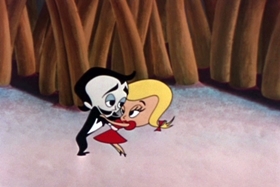 Miraculously, he hears Flora’s calls for help from the apartment above. He charges into the building, knocking down a human doorman, and rides an elevator to the top, where he breaks down the villain’s front door with a flying leap. In another lift from Avery’s “The Hick Chick”, the villain lays a punch on Flea-Wee’s jaw with hardly the effort of a wrist movement – knocking Flea-Wee backwards into the wall. Flea Wee spots a human-sized pistol mounted on the wall, and with great effort lifts and points the gun at the villan. The villain merely hops down the barrel of the pistol, producing the bullet out of the loading chamber, and drops the bullet on Flea-Wee for a brief stunning explosion. Now the villain spies a weapon – one of two crossed human swords on another mounting. He takes a swipe at Flea-Wee with one of them, carving Flea-Wee’s hat in two. Flea-Wee obtains the other sword, and they engage in a furious duel of nearly invisible dots propelling seemingly self-animated swords. (Michael Maltese would remember this bit years later for a Hanna-Barbera Augie Doggie episode titled “Swat’s the Matter”, featuring the “Three Mosquitoteers” battling Doggie Daddy.) Flea0Wee falls off a shelf, the point of his sword landing stuck in the carpet. The villain slashes at Flea-Wee’s blade, cutting his sword down to just a handle. Finally pinning Flea-Wee against a wall, the villain prepares to plunge in the blade point for the kill. But Flea-Wee yanks into position on the wall an electrical socket, into which the sword-point falls, delivering a shocking result to the villain. As Flora phones for the police (standing in the circle of a rotary-dial phone in the “0″ position and rotating the dial), Flea-Wee delivers a telling blow to the half-stuned villain. A German shepherd (the traditional “Police Dog”) arrives in the elevator, and a miniature Paddy Wagon full of “Fleastone Kops” rolls down his tail. They’re not too bright, as they first start billy-clubbing Flea-Wee, until Flora points out that they’ve got the wrong man. They finally make the arrest and cart the vllain away. Next morning, the happy couple hop down the steps of the church amidst a shower of rice from their flea guests, and board a yellow “taxi” dog for their honeymoon trip, the dog having a number of miniature tin cans and shoes tied to its swaying tail for the fade out.
Miraculously, he hears Flora’s calls for help from the apartment above. He charges into the building, knocking down a human doorman, and rides an elevator to the top, where he breaks down the villain’s front door with a flying leap. In another lift from Avery’s “The Hick Chick”, the villain lays a punch on Flea-Wee’s jaw with hardly the effort of a wrist movement – knocking Flea-Wee backwards into the wall. Flea Wee spots a human-sized pistol mounted on the wall, and with great effort lifts and points the gun at the villan. The villain merely hops down the barrel of the pistol, producing the bullet out of the loading chamber, and drops the bullet on Flea-Wee for a brief stunning explosion. Now the villain spies a weapon – one of two crossed human swords on another mounting. He takes a swipe at Flea-Wee with one of them, carving Flea-Wee’s hat in two. Flea-Wee obtains the other sword, and they engage in a furious duel of nearly invisible dots propelling seemingly self-animated swords. (Michael Maltese would remember this bit years later for a Hanna-Barbera Augie Doggie episode titled “Swat’s the Matter”, featuring the “Three Mosquitoteers” battling Doggie Daddy.) Flea0Wee falls off a shelf, the point of his sword landing stuck in the carpet. The villain slashes at Flea-Wee’s blade, cutting his sword down to just a handle. Finally pinning Flea-Wee against a wall, the villain prepares to plunge in the blade point for the kill. But Flea-Wee yanks into position on the wall an electrical socket, into which the sword-point falls, delivering a shocking result to the villain. As Flora phones for the police (standing in the circle of a rotary-dial phone in the “0″ position and rotating the dial), Flea-Wee delivers a telling blow to the half-stuned villain. A German shepherd (the traditional “Police Dog”) arrives in the elevator, and a miniature Paddy Wagon full of “Fleastone Kops” rolls down his tail. They’re not too bright, as they first start billy-clubbing Flea-Wee, until Flora points out that they’ve got the wrong man. They finally make the arrest and cart the vllain away. Next morning, the happy couple hop down the steps of the church amidst a shower of rice from their flea guests, and board a yellow “taxi” dog for their honeymoon trip, the dog having a number of miniature tin cans and shoes tied to its swaying tail for the fade out.
If you want watch it click here.
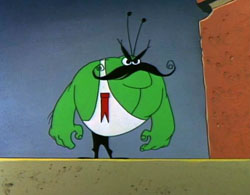 To Itch His Own (Warner, 6/28/58 – Chuck Jones, dir.), presents another script by Michael Maltese involving fleas. (As we will see, Maltese became something of the “flea king” of all cartoon writers, churning out more scripts about them than anybody.) At Norbert’s Flea Circus, we are introduced by poster art on the theatre wall to the “Mighty Angelo – World’s Strongest Flea”. He is depicted holing up a human-sized barbell with one finger, and in appearance and build is a classic human circus strong man (only colored green), in a one-piece outfit of tights held up by a singe suspender, and with a huge Victorian-style handlebar moustache. Suddenly the stge door of the theatre is knocked off its hinges from the inside, as a hopping dot emerges, and disappears down the alley, tossing trash cans a hundred times his size out of his way. Inside the theatre in the center ring rests a small cage with the bars bent from an apparent escape, and a miniature note to the management. “I’ve been working too hard so I’m going to take a rest on some nice quiet dog in the country…P.S. I’ll fix the door when I get back.” Finding a reasonably helpless looking dog on a country estate, Angelo applies the proper hold to the dog’s tail, and bends it into a staircase for himself to climb aboard. The dog starts to reflectively kick, but Angelo (demonstrating his signature gesture of untwirling the curls of his moustache into straight lines whenever he is peeved) merely stomps his foot, and flattens the dog out on his belly. Any attempt to scratch draws another stomp, until the dog, confused but observant, gets the message. A tough bulldog next door (Butcher) comes home with a bone, and decides to be a bully and make himself more comfortable, by booting the little dog off a small pillow and dragging the pillow back to his own yard. Having his rest disturbed, Angelo is peeved again. From a nearby brick wall, he loosems a brick, then drops it on the head of the bulldog, not only sealing back the pillow, but giving Butcher’s bone to the little dog (who still can’t see Angelo, and can’t figure where these gifts from nowhere are coming from).
To Itch His Own (Warner, 6/28/58 – Chuck Jones, dir.), presents another script by Michael Maltese involving fleas. (As we will see, Maltese became something of the “flea king” of all cartoon writers, churning out more scripts about them than anybody.) At Norbert’s Flea Circus, we are introduced by poster art on the theatre wall to the “Mighty Angelo – World’s Strongest Flea”. He is depicted holing up a human-sized barbell with one finger, and in appearance and build is a classic human circus strong man (only colored green), in a one-piece outfit of tights held up by a singe suspender, and with a huge Victorian-style handlebar moustache. Suddenly the stge door of the theatre is knocked off its hinges from the inside, as a hopping dot emerges, and disappears down the alley, tossing trash cans a hundred times his size out of his way. Inside the theatre in the center ring rests a small cage with the bars bent from an apparent escape, and a miniature note to the management. “I’ve been working too hard so I’m going to take a rest on some nice quiet dog in the country…P.S. I’ll fix the door when I get back.” Finding a reasonably helpless looking dog on a country estate, Angelo applies the proper hold to the dog’s tail, and bends it into a staircase for himself to climb aboard. The dog starts to reflectively kick, but Angelo (demonstrating his signature gesture of untwirling the curls of his moustache into straight lines whenever he is peeved) merely stomps his foot, and flattens the dog out on his belly. Any attempt to scratch draws another stomp, until the dog, confused but observant, gets the message. A tough bulldog next door (Butcher) comes home with a bone, and decides to be a bully and make himself more comfortable, by booting the little dog off a small pillow and dragging the pillow back to his own yard. Having his rest disturbed, Angelo is peeved again. From a nearby brick wall, he loosems a brick, then drops it on the head of the bulldog, not only sealing back the pillow, but giving Butcher’s bone to the little dog (who still can’t see Angelo, and can’t figure where these gifts from nowhere are coming from).
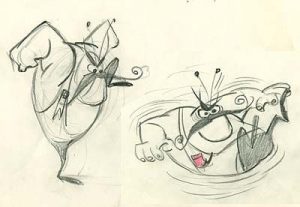 At the dog’s gate appears Butcher, tossing the brick up and down menacingly in one hand, ready for revenge. Angelo goes to work again, invisibly grabbing the bulldog’s tail, and dragging him bodily through a tiny knothole in the fece to his yard. The bulldog revives, and races toward the other dog’s yard. Here Maltese, for the second time, gets to modify the “invisibly-held objects” gag again, used in the sword duel in “Flea For Two”. A sledge hammer rises out of a barrel of tools, seemingly under its own power, but with Angelo actually manipulating the handle, and clunks the bulldog soundly on the head, stopping him in his tracks. The dog picks up the hammer, but with Angelo still attached, and the object pounds him again repeatedly, then lands an underhanded blow amounting to the equivalent of a kick in the backside. The hammer pursues the dog across the yard on “foot”, cornering him in his doghouse. The dog sees stars, as Angelo’s blows reduce the doghouse to a heap of splinters. The bulldog produces from the rubble a bottle of “Old Dog-Nip”, and swears off on the spot, tossing the bottle away. A passing dog catcher’s wagon gives the bulldog a final idea. Grabbing the little dog, he props him up on top of a fence in the dogcatcher’s view, and whisles to call the official’s attention. A net is dropped on the little dog, to haul him in. But Angelo comes to the rescue again, smacking the dogcatcher in the seat of his pants with a two-by-four – then plants the board in the hands of the snickering bulldog. Guess who the dogcatcher drags off in his net? The little dog returns to his comfortable pillow, while a miniature TV aerial rises from the dog’s fur, as Anfelo rests comfortably in a hammock strung between the dog’s hairs, watching an episode of “Glassie” (reference to the perennial “Lassie”) on a flea-sized portable TV. An historical note: This would be the last Warner cartoon to be scored by Carl Stalling.
At the dog’s gate appears Butcher, tossing the brick up and down menacingly in one hand, ready for revenge. Angelo goes to work again, invisibly grabbing the bulldog’s tail, and dragging him bodily through a tiny knothole in the fece to his yard. The bulldog revives, and races toward the other dog’s yard. Here Maltese, for the second time, gets to modify the “invisibly-held objects” gag again, used in the sword duel in “Flea For Two”. A sledge hammer rises out of a barrel of tools, seemingly under its own power, but with Angelo actually manipulating the handle, and clunks the bulldog soundly on the head, stopping him in his tracks. The dog picks up the hammer, but with Angelo still attached, and the object pounds him again repeatedly, then lands an underhanded blow amounting to the equivalent of a kick in the backside. The hammer pursues the dog across the yard on “foot”, cornering him in his doghouse. The dog sees stars, as Angelo’s blows reduce the doghouse to a heap of splinters. The bulldog produces from the rubble a bottle of “Old Dog-Nip”, and swears off on the spot, tossing the bottle away. A passing dog catcher’s wagon gives the bulldog a final idea. Grabbing the little dog, he props him up on top of a fence in the dogcatcher’s view, and whisles to call the official’s attention. A net is dropped on the little dog, to haul him in. But Angelo comes to the rescue again, smacking the dogcatcher in the seat of his pants with a two-by-four – then plants the board in the hands of the snickering bulldog. Guess who the dogcatcher drags off in his net? The little dog returns to his comfortable pillow, while a miniature TV aerial rises from the dog’s fur, as Anfelo rests comfortably in a hammock strung between the dog’s hairs, watching an episode of “Glassie” (reference to the perennial “Lassie”) on a flea-sized portable TV. An historical note: This would be the last Warner cartoon to be scored by Carl Stalling.
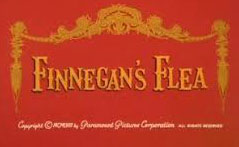 Finnegan’s Flea (Paramount/Famous, Noveltoon, 4/4/58 – I. Sparber, dir,), is the studio’s answer to Chrck Jones’s “One Froggy Evening” of a few seasons earlier. With some slight changes in message. While Jones’s epic about a singing frog sealed in a building cornerstone is a parable of the lengths one will go to for greed, and how they can backfire into a ruined life, “Finnegan” is more an observation piece on how a random act of Dame Chance can shatter people’s dreams. The scene opens in an urban saloon, where a chalk-faced derelict stands motionless and open-mouthed at the bar, Another patron asks, “Is he dead?” The bartender (voiced by Jackson Beck) says no, just frozen from the effects of a severe shock 13 years ago, on the very spot where he has stood since to this day. The bartender continues to tell that it was by his hand that the fellow (Finnegan) came to be in this state, and that he continues to make amends by inserting pretzels and beer down Finnegan’s throat every so often so he won’t starve. The tale starts back when Finnegan was doing a 20 year stretch in Alcatraz, in solitary confinement. Having no pastime except self-teaching himself how to musically crack his knuckles to a Rumba beat, Finnegan is surprised one day to hear a voice singing along with his knuckle-cracking. He thinks it’s the ghost of a former tenant who got the chair – but is relieved to find it’s a singing flea on the wall. The flea, like Michigan J. Frog, has a considerable repertoire, including old Paramount-controlled tunes like Maurice Chevalier’s “Louise” from “The Love Parade”, and Max Fleischer’s “It’s a Hap Hap Happy Day” from “Gulliver’s Travels” (adapted to the singing style of Al Jolson). Naming the flea Charlie, Finnegan is kept entertained throughout his remaining prison term. But the day comes when his term is up, and he is released a free man to face the cold cruel world again – without Charlie. The flea, only seen as a mere black dot, weeps a large tear in the window of the prison cell door.
Finnegan’s Flea (Paramount/Famous, Noveltoon, 4/4/58 – I. Sparber, dir,), is the studio’s answer to Chrck Jones’s “One Froggy Evening” of a few seasons earlier. With some slight changes in message. While Jones’s epic about a singing frog sealed in a building cornerstone is a parable of the lengths one will go to for greed, and how they can backfire into a ruined life, “Finnegan” is more an observation piece on how a random act of Dame Chance can shatter people’s dreams. The scene opens in an urban saloon, where a chalk-faced derelict stands motionless and open-mouthed at the bar, Another patron asks, “Is he dead?” The bartender (voiced by Jackson Beck) says no, just frozen from the effects of a severe shock 13 years ago, on the very spot where he has stood since to this day. The bartender continues to tell that it was by his hand that the fellow (Finnegan) came to be in this state, and that he continues to make amends by inserting pretzels and beer down Finnegan’s throat every so often so he won’t starve. The tale starts back when Finnegan was doing a 20 year stretch in Alcatraz, in solitary confinement. Having no pastime except self-teaching himself how to musically crack his knuckles to a Rumba beat, Finnegan is surprised one day to hear a voice singing along with his knuckle-cracking. He thinks it’s the ghost of a former tenant who got the chair – but is relieved to find it’s a singing flea on the wall. The flea, like Michigan J. Frog, has a considerable repertoire, including old Paramount-controlled tunes like Maurice Chevalier’s “Louise” from “The Love Parade”, and Max Fleischer’s “It’s a Hap Hap Happy Day” from “Gulliver’s Travels” (adapted to the singing style of Al Jolson). Naming the flea Charlie, Finnegan is kept entertained throughout his remaining prison term. But the day comes when his term is up, and he is released a free man to face the cold cruel world again – without Charlie. The flea, only seen as a mere black dot, weeps a large tear in the window of the prison cell door.
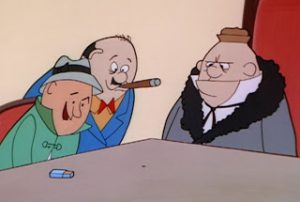 On the outside, Finnegan is a hopeless loser, having lost his skill in the only racket he ever knew – shooting pool. In a dime-a-bed flophouse, Finnegan gets a surprise serenade in the middle of the night, as the flea has followed him from prison. At the same time, Finnegan notices the contents of a stray newspaper page he had been using as a blanket – a page from Variety, announcing TV in need of new talent. “Charlie, this is our big chance”, says Finnegan, and packs Charlie in a matchbox for easy carrying. In the morning, Finnegan appears at a theatrical agent’s office, touting the flea. But the agent insists, “Where?”, as the matchbox is empty. Outside, singing is heard on the back of a dachshund (the old number “Please” from “The Big Broadcast” of 1932, in the style of its original performer, Bing Crosby). The agent approves of the sound, but before Finnegan can retrieve Charlie, Finnegan sneezes, and the flea is blown away. Finnegan spends days combing the town for any sign of the flea. Finally, he hears singing one night in the park, and finds Charlie taking refuge in the coat of a bum sleeping on a park bench (singing Bob Hope and Shirley Ross’s “Two Sleepy People”). With no thought to the bum’s well being, Finnegan steals the coat right off his back, telling Charlie, “This is it. The big time.” Nexy morning, he and the agent present Charlie at an executive board meeting for the TV studio. Charlie presents his high class repertoire, singing opera. A deadpan chairman of the board announces, “A star is born.” The agent states, “$50,000 bucks a show, or we don’t sign.” The chairman replies in straightforward underplay, “Make it $75,000. After all, what is money?” The contract is signed, and Finnegan brings Charlie to the saloon to celebrate. He orders champagne despite the place seeming to be a low class joint. The bartender (our narrator) asks “And where would a tramp like you be getting money for champagne?” “Money?”, replies Finnegan. “Why, that’s my middle name. I struck it rich. I’ve got a gold mine!” He pours Charlie out of the matchbox. “Here, see that flea?” “A flea?”, replies the bartender, and with one reflexive swat, smashes Charlie on the bar surface. With a “boingggg”, Finnegan freezes in place, and turns chalk white – and the scene dissolves back to the present day, where he still stands. “His hopes, his future wiped out by a simple swat of this stupid right hand” says the bartender. “But, on the oter hand, Finnegan;s stomach will never be empty. I’ll be seein’ to that”, as another round of beer and pretzels are force fed to Finnegan for the fade out. (We can only hope the bartender has figured out some way to deal with what comes out the other end.)
On the outside, Finnegan is a hopeless loser, having lost his skill in the only racket he ever knew – shooting pool. In a dime-a-bed flophouse, Finnegan gets a surprise serenade in the middle of the night, as the flea has followed him from prison. At the same time, Finnegan notices the contents of a stray newspaper page he had been using as a blanket – a page from Variety, announcing TV in need of new talent. “Charlie, this is our big chance”, says Finnegan, and packs Charlie in a matchbox for easy carrying. In the morning, Finnegan appears at a theatrical agent’s office, touting the flea. But the agent insists, “Where?”, as the matchbox is empty. Outside, singing is heard on the back of a dachshund (the old number “Please” from “The Big Broadcast” of 1932, in the style of its original performer, Bing Crosby). The agent approves of the sound, but before Finnegan can retrieve Charlie, Finnegan sneezes, and the flea is blown away. Finnegan spends days combing the town for any sign of the flea. Finally, he hears singing one night in the park, and finds Charlie taking refuge in the coat of a bum sleeping on a park bench (singing Bob Hope and Shirley Ross’s “Two Sleepy People”). With no thought to the bum’s well being, Finnegan steals the coat right off his back, telling Charlie, “This is it. The big time.” Nexy morning, he and the agent present Charlie at an executive board meeting for the TV studio. Charlie presents his high class repertoire, singing opera. A deadpan chairman of the board announces, “A star is born.” The agent states, “$50,000 bucks a show, or we don’t sign.” The chairman replies in straightforward underplay, “Make it $75,000. After all, what is money?” The contract is signed, and Finnegan brings Charlie to the saloon to celebrate. He orders champagne despite the place seeming to be a low class joint. The bartender (our narrator) asks “And where would a tramp like you be getting money for champagne?” “Money?”, replies Finnegan. “Why, that’s my middle name. I struck it rich. I’ve got a gold mine!” He pours Charlie out of the matchbox. “Here, see that flea?” “A flea?”, replies the bartender, and with one reflexive swat, smashes Charlie on the bar surface. With a “boingggg”, Finnegan freezes in place, and turns chalk white – and the scene dissolves back to the present day, where he still stands. “His hopes, his future wiped out by a simple swat of this stupid right hand” says the bartender. “But, on the oter hand, Finnegan;s stomach will never be empty. I’ll be seein’ to that”, as another round of beer and pretzels are force fed to Finnegan for the fade out. (We can only hope the bartender has figured out some way to deal with what comes out the other end.)
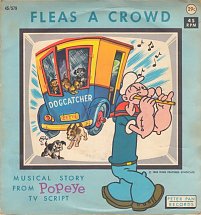 Fleas a Crowd (King Features/Format Films, Popeye, 1960 – Bob Bemiller, dir.) – In his theatrical days, Popeye dealt with the hindrances of both flies and termites – so why not add fleas to his list? But in this case, they are his friends instead of his foes. Popeye performs at the “Thimble Theatre” (a nice nod to the sailor’s creator Elzie Segar, being the name of the strip in which Popeye first appeared) with a duo of trained fleas, named Damon and Pythias (an odd reference to a pair of fabled friend from Greek legend). The fleas may be as anatomically accurate as animation ever tended to get – being depicted as little hairy purple dots with faces and limbs. A raptured Olive and a frustrated Bluto (as in all King Features episodes renamed “Brutus”) watch from the balcony. Brutus just can’t figure why Olive is so gaga over Popeye’s act. As one flea does a high dive from Popeye’s pipe into a miniature tank of water, Brutus comments, “What’s so cute about fleas taking a bath?” Deciding enough is enough, Brutus decides to make this act “go to the dogs’ – by sending onto the stage a marvelous wind-up toy canine – which seems to never wind down its mainspring, and even scratches occasionally. The “walk-on” cameo disrupts a performance of the “Damon and Pythias Waltz” (a chipmunk-speeded soft-shoe rendition of “Swanee River” – in fact, when Peter Pan Records issued an adaptation of this script on record, all they did was dub in their already-recorded imitation of Alvin and the Chipmunks performing the same song, from their sound-alike series, “Sing Along With the Grasshoppers”). The fleas jump on the toy dog’s back, and in the manner of Snagglepuss, exit stage right. Popeye, oblivious that Brutus is at work, takes off after the dog. First, the mechanical pup is spotted in heavy cross-traffic, with vehicles converging on him from all directions. Popeye leaps in to help, but the traffic all cones to a stop just shy of hitting the dog, allows him to exit, then plows into Popeye!
Fleas a Crowd (King Features/Format Films, Popeye, 1960 – Bob Bemiller, dir.) – In his theatrical days, Popeye dealt with the hindrances of both flies and termites – so why not add fleas to his list? But in this case, they are his friends instead of his foes. Popeye performs at the “Thimble Theatre” (a nice nod to the sailor’s creator Elzie Segar, being the name of the strip in which Popeye first appeared) with a duo of trained fleas, named Damon and Pythias (an odd reference to a pair of fabled friend from Greek legend). The fleas may be as anatomically accurate as animation ever tended to get – being depicted as little hairy purple dots with faces and limbs. A raptured Olive and a frustrated Bluto (as in all King Features episodes renamed “Brutus”) watch from the balcony. Brutus just can’t figure why Olive is so gaga over Popeye’s act. As one flea does a high dive from Popeye’s pipe into a miniature tank of water, Brutus comments, “What’s so cute about fleas taking a bath?” Deciding enough is enough, Brutus decides to make this act “go to the dogs’ – by sending onto the stage a marvelous wind-up toy canine – which seems to never wind down its mainspring, and even scratches occasionally. The “walk-on” cameo disrupts a performance of the “Damon and Pythias Waltz” (a chipmunk-speeded soft-shoe rendition of “Swanee River” – in fact, when Peter Pan Records issued an adaptation of this script on record, all they did was dub in their already-recorded imitation of Alvin and the Chipmunks performing the same song, from their sound-alike series, “Sing Along With the Grasshoppers”). The fleas jump on the toy dog’s back, and in the manner of Snagglepuss, exit stage right. Popeye, oblivious that Brutus is at work, takes off after the dog. First, the mechanical pup is spotted in heavy cross-traffic, with vehicles converging on him from all directions. Popeye leaps in to help, but the traffic all cones to a stop just shy of hitting the dog, allows him to exit, then plows into Popeye!
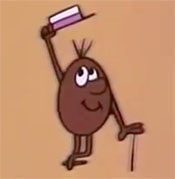 Next, the pup jumps off the end of an open drawbridge, with Popeye doing the same. The mechanical marvel sprouts a helicopter attachment out its head and gently floats down, while Popeye takes the dive. “Must be an Airedale or sump’in’”, quips Popeye. The film version seems to be missing a good line of dialog during a dog catcher sequence, possibly excised from the script during final editing, with Popeye trying to spot the mechanical dog in a wagon full of real dogs. The Peter Pan record, which tracks the original dialog script of the cartoon nearly word for word with former Popeye voice man Harry Welch taking over Jack Mercer’s role, adds the extra line “I can’‘t see the forest for the fleas!” Finally, Popeye rescues the fleas as the dog enters a gorilla cage at the zoo, giving the gorilla a sock so hard that he splits the ape into a large-scale version of Harman and Ising’s three Good Little Monkeys. Popeye makes it back to the theatre just in time for the next performance – but the fleas are exhausted and unconscious. Brutus figures he’s finally won – but Popye feeds the fleas a miniature can of spinach – and they spring back to life with the smoky explosion of a mini-atomic bomb. Brutus appears on stage to get rid of them once and for all, but Popeye commands, “Sic ‘im, boys.” Brutus makes a hasty exit while being eaten alive, and Popeye gives us the usual song and pipe toot for the closer. (Notably, this film, besides its record adaptation, was also singled out by the Kenner toy company for about a 20 ft, 8mm mini-abridgement for its hand-crank “Easy Show Movie Projector” film loops – and amazingly did the story reasonable justice with so few feet of film to spare. I’m fortunate enough to still own a print.)
Next, the pup jumps off the end of an open drawbridge, with Popeye doing the same. The mechanical marvel sprouts a helicopter attachment out its head and gently floats down, while Popeye takes the dive. “Must be an Airedale or sump’in’”, quips Popeye. The film version seems to be missing a good line of dialog during a dog catcher sequence, possibly excised from the script during final editing, with Popeye trying to spot the mechanical dog in a wagon full of real dogs. The Peter Pan record, which tracks the original dialog script of the cartoon nearly word for word with former Popeye voice man Harry Welch taking over Jack Mercer’s role, adds the extra line “I can’‘t see the forest for the fleas!” Finally, Popeye rescues the fleas as the dog enters a gorilla cage at the zoo, giving the gorilla a sock so hard that he splits the ape into a large-scale version of Harman and Ising’s three Good Little Monkeys. Popeye makes it back to the theatre just in time for the next performance – but the fleas are exhausted and unconscious. Brutus figures he’s finally won – but Popye feeds the fleas a miniature can of spinach – and they spring back to life with the smoky explosion of a mini-atomic bomb. Brutus appears on stage to get rid of them once and for all, but Popeye commands, “Sic ‘im, boys.” Brutus makes a hasty exit while being eaten alive, and Popeye gives us the usual song and pipe toot for the closer. (Notably, this film, besides its record adaptation, was also singled out by the Kenner toy company for about a 20 ft, 8mm mini-abridgement for its hand-crank “Easy Show Movie Projector” film loops – and amazingly did the story reasonable justice with so few feet of film to spare. I’m fortunate enough to still own a print.)
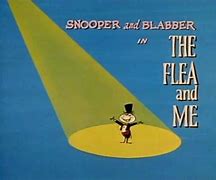 Super Snooper and Blabber Mouse, cat and mouse private detectives from Hanna-Barbera’s Quick Draw McGraw show, seem to have had the most encounters with fleas of any animated characters, chalking up four flea capers in their career, though never getting bit once. Their first was in The Flea and Me (11/3/59), in which they answer a distress call from a flea circus manager (Karl Von Scratchem Back), who reports that his star performer Rudolf has flown the coop. (History again repeats itself, setting up the same basic premise as Our Gang’s Thundering Fleas from 1926.) Rudolf is depicted on a poster as a needle-nosed bug wearing a formal top hat and tuxedo. Offered $5,000 for return of the flea, Snooper promises results “if we have to shave every dog in town.” First logical stop – the city dog pound. Only all the dogs are scratching, so how to pick out Rudolf? Eayt for Snooper, who shouts out an introduction for the performing flea like a ringmaster. Rudolf can’t resist revealing himself on the nose of one of the dogs to take a bow before his public – then realizing he’s blown his cover, Rudolf high-tails it out the back door. In the park, Rudolf jumps upon a policeman, and hides out in his hat. After a few feeble attempts to explain to the officer their mission get nowhere, Snooper orders an attack on the hat, and the two detectives jump the officer. When the hat proves empty, they remove from the cop everything else, leaving him shivering in his underwear behind a bush. But Rudolf is on the move again. Snoop and Blab follow him to the zoo.
Super Snooper and Blabber Mouse, cat and mouse private detectives from Hanna-Barbera’s Quick Draw McGraw show, seem to have had the most encounters with fleas of any animated characters, chalking up four flea capers in their career, though never getting bit once. Their first was in The Flea and Me (11/3/59), in which they answer a distress call from a flea circus manager (Karl Von Scratchem Back), who reports that his star performer Rudolf has flown the coop. (History again repeats itself, setting up the same basic premise as Our Gang’s Thundering Fleas from 1926.) Rudolf is depicted on a poster as a needle-nosed bug wearing a formal top hat and tuxedo. Offered $5,000 for return of the flea, Snooper promises results “if we have to shave every dog in town.” First logical stop – the city dog pound. Only all the dogs are scratching, so how to pick out Rudolf? Eayt for Snooper, who shouts out an introduction for the performing flea like a ringmaster. Rudolf can’t resist revealing himself on the nose of one of the dogs to take a bow before his public – then realizing he’s blown his cover, Rudolf high-tails it out the back door. In the park, Rudolf jumps upon a policeman, and hides out in his hat. After a few feeble attempts to explain to the officer their mission get nowhere, Snooper orders an attack on the hat, and the two detectives jump the officer. When the hat proves empty, they remove from the cop everything else, leaving him shivering in his underwear behind a bush. But Rudolf is on the move again. Snoop and Blab follow him to the zoo.
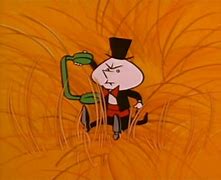 There, he disappears into the fur on a monkey in a cage. The cat and mouse enter with a hair clipper and strip the monkey bare – but Rudolf is one leap ahead of them and already heading for another cage – this time the lion. Snooper orders Blab to sneak inside the cage while the lion’s asleep and retrieve Rudolf. Without question, Blabber follows orders, leaving even Snooper perplexed. “Fantastical. He does everything I say!” But Blabber gets trapped in the grip of one of the sleepy lion’s paws. At Snoop’s suggestion, Blabber sings the lion “Rock a Bye Baby”, in the most off-key fashion imaginable. As the lion dozes off, Snooper grabs Blabbers hand and tries to pull him out. But the lion’s hold is so strong that Snooper is instead pulled into the cage by Blabber’s arm as if it were a rubber band snapping back to original shape. Now both held in the lion’s paws, the only thing left to do is for Blabber to keep singing – all night – so that the lion doesn’t get any culinary ideas. Blabber nears exhaustion, but Snooper’s orders and the lion’s growls prompt him to keep singing. (Isn’t this almost the same ending as the Flintstones’ The Flintstone Flyer, coupled with Alex Lovy’s stablemate Tex Avery’s Legend of Rockabye Point?) Rudolf ends the film in the lion’s fur, putting on a pair of earmuffs so he can sleep through Blabber’s awful singing.
There, he disappears into the fur on a monkey in a cage. The cat and mouse enter with a hair clipper and strip the monkey bare – but Rudolf is one leap ahead of them and already heading for another cage – this time the lion. Snooper orders Blab to sneak inside the cage while the lion’s asleep and retrieve Rudolf. Without question, Blabber follows orders, leaving even Snooper perplexed. “Fantastical. He does everything I say!” But Blabber gets trapped in the grip of one of the sleepy lion’s paws. At Snoop’s suggestion, Blabber sings the lion “Rock a Bye Baby”, in the most off-key fashion imaginable. As the lion dozes off, Snooper grabs Blabbers hand and tries to pull him out. But the lion’s hold is so strong that Snooper is instead pulled into the cage by Blabber’s arm as if it were a rubber band snapping back to original shape. Now both held in the lion’s paws, the only thing left to do is for Blabber to keep singing – all night – so that the lion doesn’t get any culinary ideas. Blabber nears exhaustion, but Snooper’s orders and the lion’s growls prompt him to keep singing. (Isn’t this almost the same ending as the Flintstones’ The Flintstone Flyer, coupled with Alex Lovy’s stablemate Tex Avery’s Legend of Rockabye Point?) Rudolf ends the film in the lion’s fur, putting on a pair of earmuffs so he can sleep through Blabber’s awful singing.
Poodle Toodle-oo!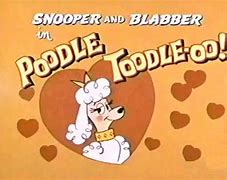 (9/5/60) has a prize-winning female French poodle (Frou-Frou) disappear from the dog show where she’s just been awarded first prize – and no one knows why. (An interesting continuity error appears between the art department and the voice talent – as no one notices that the script calls for a “silver” loving cup trophy, yet the cup depicted on screen is golden!) As Snooper and Blabber are called in on the case, they discover an unusual means of assistance. A lone occupant remains in the poodle’s stall – a small French-accented flea wearing a beret and a striped shirt of the standard apache variety – named Toot Sweet. He offers his assistance to recover the pooch. “What’s in it for you?” asks Snooper. The flea points out that if the poodle is not found, he’s out one happy home. Snooper instantly deputizes the flea, while Blabber weeps at the solemn occasion of such a swearing in ceremony. The cross-city chase leads our three detectives into an encounter with a bulldog who fights to uphold the lady’s honor (while himself trying to steal kisses from her). Snooper takes several socks right in the kisser, but Toot Sweet applies a judo hold and flips and clobbers the dog but good. Next, the poodle hides out in a furrier’s shop, reappearing draped around a lady’s neck. Snooper grabs the dog, and tries to explain the setup to the lady – but gets bashed again for his trouble. The poodle springs to life, thanks the lady, and zips away. The woman (voiced by Jean Vander Pyl in a voice close to her Wilma Flintstone) calmly addresses the audience. “I bet you think I’m going to scream in sheer terror. – – – Well you’re right. AHHHHHHHHH!!!!” Toot Sweet appears and asks directions to the pooch. “Hold on to your hats, folks. Here I go again”, says the lady. “AHHHHHHHHHHH!!!!” Finally, at the docks, the poodle mounts the gangplank of a steamship which has just landed. A male french poodle stands at the top of the ramp, having sailed all the way from Paris to be reunited with his lady love, and Frou-Frou leaps into his arms. Despite his usually money-hungry disposition, Snooper has a weakness for “l’amour”, and refuses to interrupt the lovers’ tryst, foregoing the reward. Instead, he expands his own practice, taking up a specialty in lost dog cases, putting his new operative Toot Sweet in charge of all such new assignments, with Blabber relegated to position of Toot Sweet’s assistant. “Oh well”, says Blabber, resigning himself to his fate, “C’est la guerre.”
(9/5/60) has a prize-winning female French poodle (Frou-Frou) disappear from the dog show where she’s just been awarded first prize – and no one knows why. (An interesting continuity error appears between the art department and the voice talent – as no one notices that the script calls for a “silver” loving cup trophy, yet the cup depicted on screen is golden!) As Snooper and Blabber are called in on the case, they discover an unusual means of assistance. A lone occupant remains in the poodle’s stall – a small French-accented flea wearing a beret and a striped shirt of the standard apache variety – named Toot Sweet. He offers his assistance to recover the pooch. “What’s in it for you?” asks Snooper. The flea points out that if the poodle is not found, he’s out one happy home. Snooper instantly deputizes the flea, while Blabber weeps at the solemn occasion of such a swearing in ceremony. The cross-city chase leads our three detectives into an encounter with a bulldog who fights to uphold the lady’s honor (while himself trying to steal kisses from her). Snooper takes several socks right in the kisser, but Toot Sweet applies a judo hold and flips and clobbers the dog but good. Next, the poodle hides out in a furrier’s shop, reappearing draped around a lady’s neck. Snooper grabs the dog, and tries to explain the setup to the lady – but gets bashed again for his trouble. The poodle springs to life, thanks the lady, and zips away. The woman (voiced by Jean Vander Pyl in a voice close to her Wilma Flintstone) calmly addresses the audience. “I bet you think I’m going to scream in sheer terror. – – – Well you’re right. AHHHHHHHHH!!!!” Toot Sweet appears and asks directions to the pooch. “Hold on to your hats, folks. Here I go again”, says the lady. “AHHHHHHHHHHH!!!!” Finally, at the docks, the poodle mounts the gangplank of a steamship which has just landed. A male french poodle stands at the top of the ramp, having sailed all the way from Paris to be reunited with his lady love, and Frou-Frou leaps into his arms. Despite his usually money-hungry disposition, Snooper has a weakness for “l’amour”, and refuses to interrupt the lovers’ tryst, foregoing the reward. Instead, he expands his own practice, taking up a specialty in lost dog cases, putting his new operative Toot Sweet in charge of all such new assignments, with Blabber relegated to position of Toot Sweet’s assistant. “Oh well”, says Blabber, resigning himself to his fate, “C’est la guerre.”
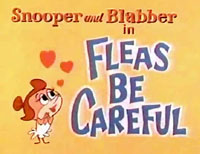 Fleas Be Careful (1960, air date unknown) is a near remake of Walter Lantz’s Flea For Two (Why not? Michael Maltese wrote both scripts, and all scripts for the Snooper and Blabber series), with a return of Toot Sweet on his wedding day, but minus one bride – as his intended has run off with a slick city flea who’s promised her a break in show biz. Toot Sweet calls on his old friends Snooper and Blabber to help in the investigation. Their first stop is a flea circus, where the proprietor says he saw the two and gave the girl an audition – but she couldn’t sing a note. He says the two disappeared into a nearby hotel after that. From an upper story window is heard the cries of Toot Sweet’s girl, calling to be saved from the city slicker, who is trying to woo her with a human-sized glass of champagne. (How close to “Flea For Two” can you get?) The slicker even has the same suave debonaire look as his Lantz counterpart. Toot Sweet demonstrates amazing strength, by breaking down a front door Snooper couldn’t even budge (the same as Flea-Wee in “Flea For Two”). Inside, the two contenders resort to fisticuffs, until Snooper suggests they settle things in more gentlemanly fashion – a duel. Instead of swords as in Lantz’s version, these two choose pistols. Of course, the villain cheats on the count of paces, and fires first. Toot Sweet falls, claiming to be – how do you say it – plugged. But his girl isn’t going to let the villain get off that easy, and pushes a heavy flower pot onto his head. The villain gives up and is micro-cuffed, while Toot Sweet revives, and states, like all heroes, that it was only a flesh wound. The final scene is nearly identical to “Flea For Two”, with Toot Sweet and his bride boarding a dog taxi en route to Niagara Falls, while a teary-eyed Snooper and Blabber throw rice.
Fleas Be Careful (1960, air date unknown) is a near remake of Walter Lantz’s Flea For Two (Why not? Michael Maltese wrote both scripts, and all scripts for the Snooper and Blabber series), with a return of Toot Sweet on his wedding day, but minus one bride – as his intended has run off with a slick city flea who’s promised her a break in show biz. Toot Sweet calls on his old friends Snooper and Blabber to help in the investigation. Their first stop is a flea circus, where the proprietor says he saw the two and gave the girl an audition – but she couldn’t sing a note. He says the two disappeared into a nearby hotel after that. From an upper story window is heard the cries of Toot Sweet’s girl, calling to be saved from the city slicker, who is trying to woo her with a human-sized glass of champagne. (How close to “Flea For Two” can you get?) The slicker even has the same suave debonaire look as his Lantz counterpart. Toot Sweet demonstrates amazing strength, by breaking down a front door Snooper couldn’t even budge (the same as Flea-Wee in “Flea For Two”). Inside, the two contenders resort to fisticuffs, until Snooper suggests they settle things in more gentlemanly fashion – a duel. Instead of swords as in Lantz’s version, these two choose pistols. Of course, the villain cheats on the count of paces, and fires first. Toot Sweet falls, claiming to be – how do you say it – plugged. But his girl isn’t going to let the villain get off that easy, and pushes a heavy flower pot onto his head. The villain gives up and is micro-cuffed, while Toot Sweet revives, and states, like all heroes, that it was only a flesh wound. The final scene is nearly identical to “Flea For Two”, with Toot Sweet and his bride boarding a dog taxi en route to Niagara Falls, while a teary-eyed Snooper and Blabber throw rice.
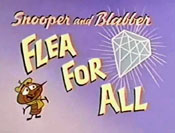 Flea For All (2/27/61) marks the final appearance of Toot Sweet, in a darker and less colorful color pattern than his previous two appearances. The crime this time is a jewel heist from Spiffany’s jewelers – where priceless diamonds take off by themselves with no visible bandit. In reality, they are being carried by fleas, trained for theivery by the proprietor of a local flea circus. Snooper and Blabber manage to follow the last diamond to his theatre, but are chased away in a hail of bullets. Snooper realizes this is a case for their old pal, Toot Sweet.
Flea For All (2/27/61) marks the final appearance of Toot Sweet, in a darker and less colorful color pattern than his previous two appearances. The crime this time is a jewel heist from Spiffany’s jewelers – where priceless diamonds take off by themselves with no visible bandit. In reality, they are being carried by fleas, trained for theivery by the proprietor of a local flea circus. Snooper and Blabber manage to follow the last diamond to his theatre, but are chased away in a hail of bullets. Snooper realizes this is a case for their old pal, Toot Sweet.
Next day, an Airmail letter arrives from France. Inside, Toot Sweet in the flesh. Snooper and Sweet devise a plan for the flea to audition for the flea circus and infiltrate its ranks. At the evening performance, Toot Sweet is announced to perform his reenactment of the Charge of the Light Brigade. Toot charges, leading on his troops – which consist of the other fleas, carrying the stolen diamonds. They make a getaway onto the back of a waiting shaggy dog outside. Snooper, dressed as a little old lady in the audience, attempts to make the arrest, but is ultimately saved in a game of who has the drop on whom by a pistol packing Toot Sweet returning from the dog taxi. As the case closes, Snooper and Blab bid a fond farewell to Toot Sweet, who mounts a miniature set of stairs as if about to board a plane – but they lead instead to an air-mail window envelope for which Snooper has graciously provided the stamps, and deposits in the mailbox. Blabber compliments Snooper’s generosity to the audience, pointing out that nothing’s too good for his friends.
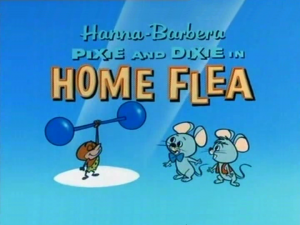 Home Flea (1962), one of the last episodes of Mr. Jinks and Pixie and Dixie produced by Hanna-Barbera for the Huckleberry Hound show, was a poor man’s rip-off of Warner’s To Itch His Own, featuring as this week’s visitor a circus strong man flea (Mighty Mite, wearing a gymnasium style shirt and short pants, and with a long nose almost resembling a mosquito stinger) in search of a new home. Pixie and Dixie talk him onto adopting Jinks. “Talk him” is right, as the episode is overburdened with dialogue and nearly lacking in action, except for an occasional judo flip by Mite every time Jinks tries to use the “wet broom treatment’ on the “meeces”. The film is largely forgettable, save for a few typical massacres by Jinks of the English language. In the Los Angeles market, Channel 11, who had spliced elements of the “Yogi Bear” and “Huckleberry Hound” shows into half-hour reels under the umbrella banner of Yogi Bear, found they had a handful more supporting cartoons than they had Yogi episodes to splice them to, and so left several titles out of regular circulation, save for sporadic drop-ins on miscellaneous shows such as “Cartoon Town” or maybe “Sheriff John”. “Home Flea” was singled out for such non-circulation, and I recall it running only once, with its credits and end card not even spliced off (as was the custom for the half-hour reels). The “Yowp” website has also referred to the film as “lacklustre”. The verdict seems unanimous that this was a loser.
Home Flea (1962), one of the last episodes of Mr. Jinks and Pixie and Dixie produced by Hanna-Barbera for the Huckleberry Hound show, was a poor man’s rip-off of Warner’s To Itch His Own, featuring as this week’s visitor a circus strong man flea (Mighty Mite, wearing a gymnasium style shirt and short pants, and with a long nose almost resembling a mosquito stinger) in search of a new home. Pixie and Dixie talk him onto adopting Jinks. “Talk him” is right, as the episode is overburdened with dialogue and nearly lacking in action, except for an occasional judo flip by Mite every time Jinks tries to use the “wet broom treatment’ on the “meeces”. The film is largely forgettable, save for a few typical massacres by Jinks of the English language. In the Los Angeles market, Channel 11, who had spliced elements of the “Yogi Bear” and “Huckleberry Hound” shows into half-hour reels under the umbrella banner of Yogi Bear, found they had a handful more supporting cartoons than they had Yogi episodes to splice them to, and so left several titles out of regular circulation, save for sporadic drop-ins on miscellaneous shows such as “Cartoon Town” or maybe “Sheriff John”. “Home Flea” was singled out for such non-circulation, and I recall it running only once, with its credits and end card not even spliced off (as was the custom for the half-hour reels). The “Yowp” website has also referred to the film as “lacklustre”. The verdict seems unanimous that this was a loser.
Though I don’t recall ever seeing an actual flea appear on the screen, brief mention should be made of the cartoon series King Leonardo and His Short Subjects (1960-63, resyndicated as The King and Odie) from Total Television, which featured as a regular nemesis to the King (a lion) his younger brother, whose primary character traits were the disposition of a beatnik, a scraggly mane with practically no hair, and an overload of fleas in his fur that always made him scratch – hence his name, “Itchy Brother”. Whil Itchy alone had little of the self-drive and none of the smarts to make a challenge for the throne, he was befriended by a criminal type who talked something like Edward G. Robinson, name “Biggy Rat”, who saw possibilities in this slovenly scarecrow of a lion to stage a Coup D’Etat by trickery and cunning plans, and hoped to ride on the coattails of friendship with the new regime into a position of importance for himself. To counter this menace, the king, a blustering monarch who loves to give orders but is un reality quite gullible without his advisors, has in his corner “ever faithful, true blie” prime minister Odie O-Cologne” (a skunk, with voice mirroring Ronald Colman), who is the real brains behind the throne and saves king and kingdom time and again. Such were the batle lines drawn for the run of the series, which lasted successfully for a few seasons, and saw many years of resyndication of various elements, sometimes in entirely different shows such as “Tennessee Tuxedo and his Tales”, and on local stations in pair-ups with Jay Ward cartoons.
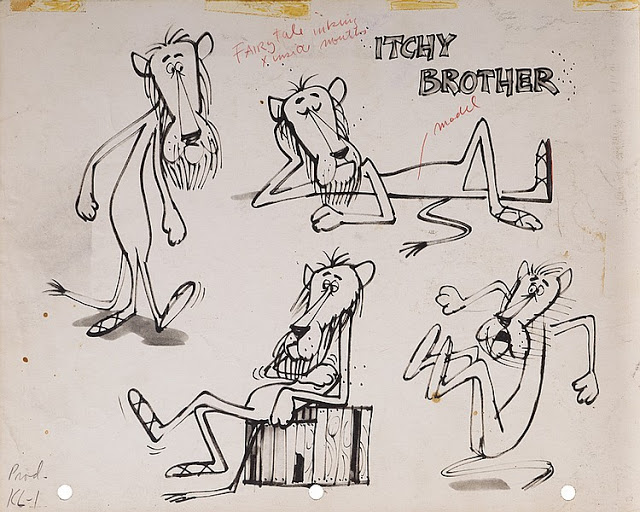
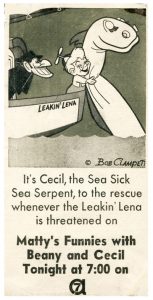 The Fleastone Kop Kaper (6/2/62), an episode of Bob Clampett’s “Beany and Cecil” animated series originally aired as “Matty’s Funnies’ for Mattel, really doesn’t give its title characters too much to do. They are merely cameos in a dog detective show Beany and Cecil are watching on TV, “The Defective Story” starring Fido Vance (play on words on the famous literary and screen detective series, Philo Vance). Dishonest John joins their audience, claiming he read in TV Guide that the bad guy wins in tonight’s episode. The case, set in Jollywood, is riddled with the usual array of Clampett plays-on-words and puns. Vance’s office is at police “hindquarters” inside a fire hydrant. Between cases, Vance reads “Here Boy” magazine (featuring a rabbit on the cover, to make sure no one misses the Hugh Hefner reference). He is sent by Chief Bowser to investigate the disappearance of studio starlet, Bridgette Bow-Wow (reference to Brigitte Bardot). Vance asks for details, and gets measurements. “Okay, chief, shoot”, he says into the phone. A hail of bullets follows from the earphone. “Yeah, well the same to you, Bowser”, says Vance, shooting into the mouthpiece, and from audio indication on the other end of the line plugging the chief. Vance passes parodies of all the major studios en route to the crime scene, including “Bob Clam-pup Cartoons, whoe pictures are all dogs.” Suspect is a dog called Doberman, alias the Pincher, who escapes with Bridgette tied in a mail sack. Vance calls for backup: “Cur 54, where you at?” (Reference to hit NBC series, Car 54, Where Are You? starring Fred Gwynne (Herman Munster) and Joe E. Ross and also featuring Al Lewis (Grandpa Munster)).
The Fleastone Kop Kaper (6/2/62), an episode of Bob Clampett’s “Beany and Cecil” animated series originally aired as “Matty’s Funnies’ for Mattel, really doesn’t give its title characters too much to do. They are merely cameos in a dog detective show Beany and Cecil are watching on TV, “The Defective Story” starring Fido Vance (play on words on the famous literary and screen detective series, Philo Vance). Dishonest John joins their audience, claiming he read in TV Guide that the bad guy wins in tonight’s episode. The case, set in Jollywood, is riddled with the usual array of Clampett plays-on-words and puns. Vance’s office is at police “hindquarters” inside a fire hydrant. Between cases, Vance reads “Here Boy” magazine (featuring a rabbit on the cover, to make sure no one misses the Hugh Hefner reference). He is sent by Chief Bowser to investigate the disappearance of studio starlet, Bridgette Bow-Wow (reference to Brigitte Bardot). Vance asks for details, and gets measurements. “Okay, chief, shoot”, he says into the phone. A hail of bullets follows from the earphone. “Yeah, well the same to you, Bowser”, says Vance, shooting into the mouthpiece, and from audio indication on the other end of the line plugging the chief. Vance passes parodies of all the major studios en route to the crime scene, including “Bob Clam-pup Cartoons, whoe pictures are all dogs.” Suspect is a dog called Doberman, alias the Pincher, who escapes with Bridgette tied in a mail sack. Vance calls for backup: “Cur 54, where you at?” (Reference to hit NBC series, Car 54, Where Are You? starring Fred Gwynne (Herman Munster) and Joe E. Ross and also featuring Al Lewis (Grandpa Munster)).
A police dog whose racing feet seem to transform into wheels brings along the Fleastone Kops in a matchbox. Each wears an oversize police helmet and little police outfit like their live action counterpart, the Keystone Kops of Mack Sennett. Throughout the mad chase through the movie sets, they do nothing but fly in formation, creating an arrow to point the way to the villain (at one point being criticized by him: “It ain’t polite to point”). The Kops eventually abandon the chase to take a lunch break at the “Flea House of the August Moon” (play on “Tea House” in a contemporary movie title). The Pincher and Bridgette catch a departing ship from the set of “Canine Mutiny on the Bounty” (play on Columbia’s “The Caine Mutiny” as well as MGM’s “Bounty” remake with Marlon Brando), and leave Vance and the police dog dunked in the drink, as the show goes into its final commercial break. Dishonest John gloats that he was right about the bad guy winning – until the show’s epilogue appears, with the Pincher in “solitary” confinement – actually far from solitary, as he is a henpecked husband to Bridgette who has grown fat and lazy, and washing diapers for a roomful of kids (sort of Porky Pig’s nightmare from Porky’s Romance). Now it is Beany and Cecil’s turn to gloat, as a deflated DJ leaves the room in misery as usual.
Next Week: A flea performs a feat of superhuman strength by carting home an Oscar.


 Charles Gardner is an animation enthusiast who toils by day as a member of LA Law – but by nights and weekends indulges in classic jazz and ragtime as a performer; and studies classic Hollywood cartoons… maybe a little too much.
Charles Gardner is an animation enthusiast who toils by day as a member of LA Law – but by nights and weekends indulges in classic jazz and ragtime as a performer; and studies classic Hollywood cartoons… maybe a little too much.


































































































































































An additional late-discovery. “Golden-Type Fleece” (King Features, Popeye, circa 1960 – Jack Kinney, dir., is a better than usual Kinney period piece, as told by Popeye to Swee’pea (rather than another Professor Whattaschnozzle time travel episode wasting airtime on stock footage). Popeye plays Jason the Argonaut, on a mission from the King of Greece (Wimpy) to obtain the golden fleece for his queen (The Sea Hag) (an interesting pairing, but not out of character for the series, as an original strip by Segar once had Wimpy bargain a night of romance to the Sea Hag in return for hamburgers). After epic encounters with Zeus, Neptune, and even a trio of Gooney sirens attempting to lure Jason to the rocks with a rock tune, Jason Popeye finally finds the object of his quest in a sideshow. But the reconnaissance of the king is a bit off, as there is no golden fleece – just golden fleas, in a flea circus. Popeye returns with his find, and despite the drastic switch of quarry, Wimpy is satisfied – as the queen is kept so busy scratching fleas that Wimpy can now eat his hamburgers without her constant nagging.
Another flea-rific Animation Trail, and I’m especially happy to see Snooper and Blabber again. I love Maltese’s fleases to pieces!
The Mighty Angelo has guest starred in a couple episodes of the New Looney Tunes show. In one, he decides to infest Bugs Bunny, who, instead of making the best of it like the dog in “To Itch His Own”, unsuccessfully tries to get rid of him. In the other, Angelo, told he’s too small to be a professional wrestler, takes up residence on the unsuspecting bulldog Marc Antony and manipulates him like a puppet in a wrestling match with the “Great Calzone”.
The aria heard in “Finnegan’s Flea” is “Ach, wie fromm” from the opera “Martha” by Friedrich von Flotow, sung in Italian instead of the original German. Popeye sings it (with lyrics adapted to the balcony scene from Romeo and Juliet) in the 1940 Fleischer cartoon “Shakespearean Spinach”.
I don’t recall seeing any fleas in the King Leonardo cartoons either, but they’re mentioned in the theme song: “Good King Leonardo has his enemies, / Biggie with his pistols and Itchy with his fleas.”
Looking forward to next week’s infestation!
A fine post in every respect. I remembered the Lantz and Jones flea-themed shorts with some affection (the Patterson directed “Flea for Two” was frequently seen in syndication), but I never realized that Mike Maltese had written both.
A highlight here is certainly Paramount’s “Finnegan’s Flea.” Like a number of late ’50s shorts from the studio, it’s surprisingly well conceived and sharply designed, despite its very limited use of animation; it may be clearly inspired by “One Froggy Evening,” but the cartoon has something to offer in its own right. A real plus is the short’s skillful use of the Famous Music catalogue; those old Paramount standards, well performed by an uncredited vocalist (does anyone know who voiced Charlie?), really put the idea across that this is one talented flea.
The funniest thing in the cartoon, though, is the stone-faced curmudgeon of a TV executive (voiced by Jackson Beck) who ends up championing the flea when he hears Charlie sing opera, even offering Finnegan and his greedy agent more than their asking price. “After all,” he croaks flatly, “What is money?”
Thanks Charles!
How To Itch His Own never made it to home video is a head-scratcher. I forgot how laff-out-loud funny this title is. Amazing how Jones was turning out such quality work late in the game, while Freleng and McKimson had gone stale by that time.
“An historical note: This would be the last Warner cartoon to be scored by Carl Stalling.”
Interesting story, that: I was browsing around the SABAM site a while back and came across the cue sheet for 1959’s “Mexicali Shmoes”. It listed not only Milt Franklyn (who was the credited composer) but… Carl Stalling? A year after his retirement? Here’s a screenshot for proof: https://ibb.co/tMQZNHS
Having watched the cartoon again, and based off the time code listed here, my educated guess is that Stalling provided the recurring guitar melody for the two cats, but Franklyn handled all the other scenes. I have two theories as to why Stalling wasn’t credited: 1) Due to the rule at the time of not listing former staff members, he was omitted, or 2) Stalling had provided these melodies before finishing up on “To Itch His Own” and Franklyn merely used his contributions in the final cartoon, even though Stalling had already left the studio by this time.
In “Foxed by a Fox” (Fox/Terrytoons, 1/8/55 — Connie Rasinski, dir.), a fox, tired of being chased by a hunter and his dog, grabs the animator’s pencil, eraser, paints and brushes, and takes control of the cartoon. It’s no “Duck Amuck”, but it’s still pretty funny, and it contains a one-of-a-kind flea gag.
Using the animator’s magic pencil, the fox draws a picture of a flea, which comes to life and begins to hop about; and while the dog is distracted by it, the fox ties an eraser to the dog’s hind foot. When the flea jumps on board and the dog begins scratching himself, he erases his midsection, and then his fore and aft halves run around separately. At least he got rid of his flea problem….
I have to say, “Flea for Two” was nice one-shot by Don Patterson. I even liked it better than Tex’s flea circus cartoon from a few years early. It’s a shame that not only it was Don’s only non-Woody cartoon but the his last Lantz cartoon period. One wonders what Don would do with Chilly and the new-steamlined Woody had he lasted longer at Lantz.